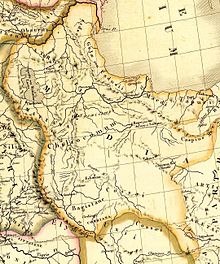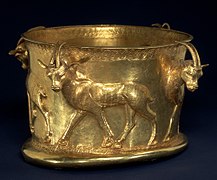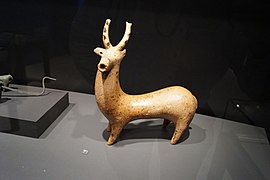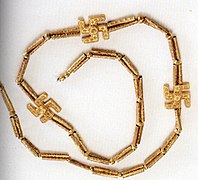Amardi
| Part of a series on the History of Tabaristan |
|---|
 |
|
|

The Amardians, widely referred to as the Amardi (and sometimes Mardi), were an ancient
They lived in the valleys in between the Susis and Persis,[6] in what is now southwestern Iran. The southern Mardi are described by Nearchus as one of the four predatory mountain peoples of the southwest, along with the Susians, Uxii, and Elymaeans.[7] Of these four nomadic groups, they were the only tribe linguistically Iranian.[8]
Etymology
The term Mardi comes from the
, "mortal").Mazanderan), at least in the period starting from the Sasanian Empire to the Ilkhanate of the Mongol Empire
.
Historical accounts
Persian tribes in Persis.[1][5] They lived in the valleys in between the Susis and Persis,[11] in what in now southwestern Iran. The southern Mardi are described by Nearchus as one of the four predatory mountain peoples of the southwest, along with the Susians, Uxii, and Elymaeans.[7] Of these four nomadic groups, they were the only tribe linguistically Iranian.[12]
Gallery
-
Map of the Median Empire (600 BC), showing the relative locations of the Amardian tribe.
-
The Hyrcanian Golden cup. Dated first half of first millennium. Excavated atMazandaran.
-
Deer stag Marlik
See also
Further reading
- "The Mardians: A Note" (PDF). Leonardo Gregoratti (Durham University, UK). Anabasis, Studies for Classical Eastern Orientalism.
References
- ^ a b c "IRAN" [v. PEOPLES OF IRAN (2) Pre-Islamic]. Encyclopædia Iranica. Vol. XIII. Retrieved July 20, 2017.
- ISBN 9780801024320 – via Google Books.. Vol. 2. Iran Society. 1947. p. 21 – via Google Books.
- Smith, William (1854). Dictionary of Greek and Roman Geography. Vol. 1. Little, Brown & Company – via Google Books.
- Indo-iranica - ^ ISBN 9780924171321.
- ^ Norris, Edwin (1853). Memoir on the Scythic Version of the Behistun Inscription. Harrison and Sons.
- ^ ISBN 9780933273955. Retrieved May 21, 2020.
- ^ ISBN 9780848207410.
- ^ a b c "CASPIANS". Encyclopædia Iranica. Vol. V. p. 62. Retrieved July 20, 2017.
- ^ electricpulp.com. "IRAN v. PEOPLES OF IRAN (2) Pre-Islamic – Encyclopaedia Iranica". www.iranicaonline.org. Retrieved 2017-08-07.
- ^ Richard N. Frye. "Ancient Central Asian History Notes". Proceedings of the Second European Congress of Iranian Studies. Rome: ISMEO. p. 188.
town of Amul on the Amu Darya and the Amul in Mazanderan, Iran, both of which may be traced back to the migration of an Iranian tribe called Amardi or Mardi
- ^ "GĪLĀN" [iv. History in the Early Islamic Period]. Encyclopædia Iranica. Vol. X. pp. 634–635. Retrieved July 20, 2017.
- Wright, John Henry (1905). A history of all nations from the earliest times. Lea Brothers. - ^ Eadie, John (1852). Early Oriental History, Comprising the Histories of Egypt, Assyria, Persia, Lydia, Phrygia, and Phoenicia. Griffin. p. 276.
mardi.
- ^ electricpulp.com. "IRAN v. PEOPLES OF IRAN (2) Pre-Islamic – Encyclopaedia Iranica". www.iranicaonline.org. Retrieved 2017-08-07.





